Wildlife, Landscapes & Local Culture: Travel Guide to Nyerere National Park
Nyerere National Park, located in southern Tanzania, is one of Africa’s most spectacular and untamed wilderness areas, promising visitors an unforgettable experience of nature’s raw beauty. Being the largest national park on the continent, it is an unbelievable 30,893 square kilometers of landscape diversity, including the great savannahs, the woodlands, and winding river systems
Formerly part of the famous Selous Game Reserve, the park offers an authentic safari experience away from mainstream crowds, where elephants roam freely, lion prides patrol the plains, and numerous bird species fill the skies with color and song. Whether you want to take a boat safari on the Rufiji River, crave the excitement of game drives, or just want to relax under African skies, Nyerere National Park will get you in touch with your inner adventurous soul. This travel guide reveals necessary knowledge, tips, and secrets to help you plan an outstanding tour to this untameable yet spectacular part of Tanzania.
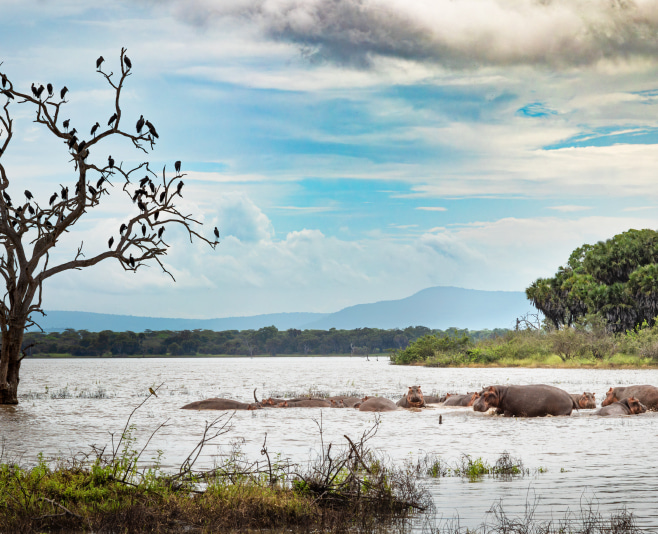
For visitors looking for a rich range of wildlife, the Nyerere National Park is an excellent choice
- 1. Why Visit Nyerere National Park?
- 2. Best Time to visit Nyerere National Park
- Nyerere national park fees and opening hours
- How to get to Nyerere national park
- What to do in Nyerere National Park?
- Top accommodations in Nyerere National Park
- Practical Tips for Visiting Nyerere National Park
- Conclusion
1. Why Visit Nyerere National Park?
Nyerere National Park is very wild and teeming with wild game and it is the largest national park in Africa. However unlike the more renowned destinations on Tanzania northern safari circuit, it is relatively unknown to the outside world.
Unique Water-Based Safaris
The characteristic feature of the park is the Rufiji River, the largest river in Tanzania, meandering through the territory of the park forming a complicated network of oxbow lakes, channels, and swamps. This allows for:
- Boat Safaris: One of the highlights of Nyerere, boat safaris are an experience in a league of their own. You can be extremely near to hippos and crocodiles, you may see a great number of water birds, and you even may watch elephants, buffalo, and giraffes coming to the riverbanks to drink. Sunset boat rides are particularly enchanting, offering magical views as the sun sets over the Rufiji River.
- Fishing: Tiger fish and the numerous species of catfish can be caught and released upon specified places.
Abundant Wildlife & High Biodiversity
Nyerere is a haven for an incredible diversity of wildlife.
- Elephants: It is home to one of the biggest populations of elephants in Africa, especially in large herds.
- African Wild Dogs: The endangered African wild dog (painted wolf) is a top predator that can also be found in the park; hence, it is the ideal destination to observe the predators in Tanzania.
- Lions & Leopards: Nyerere hosts strong populations of lions and leopards, particularly near riverine areas. Cheetahs are present in the park but are less common than in places like the Serengeti, and they are typically found in more open terrain.
- Buffalo & Giraffe: They can see large herds of buffalo and a lot of giraffes.
- Birdlife: Nyerere being the paradise of birders, there are more than 440 species of birds recorded, with an array of savannah birds and water-dependent birds.
Uncrowded & Authentic Wilderness
Nyerere National Park provides the real feel of wilderness. The park is so large and sometimes less visited, and you can have a chance to enjoy game viewing, and often without seeing a lot of other safari vehicles, having a special relationship with nature. Such a sense of isolation and unspoiled nature is a significant attraction.
Diverse Landscapes
Further on the other side of the river, the diversity of land cover in the park includes extensive miombo woodlands, the open grasslands, and the dense acacia bush; each land cover sustains ecosystems and provides the visitor with different game viewing experiences.
2. Best Time to visit Nyerere National Park
The best time to visit Nyerere National Park could turn your safari from something unforgettable to something superb. The dry season usually runs from June to October, while the rainy season is divided into two phases: the short rains in November and December, and the long rains from March to May. These months enjoy a delightful warmth, and vegetation is less luxuriant: it is much easier to observe animals forming around the Rufiji River and the waterholes still filled with water. The game viewing is at its very best, and the elephants, lions, buffaloes, and occasionally even the elusive wild dogs are more frequently seen.
The rainy season, or the green season, November to May, has a special attraction of its own. There is a lot of rain that comes during this time, but this converts the park into a green paradise with bright colors and various birdlife. It is a good bird-watching season with migrating birds coming in season, and the scenery is just out of this world. In addition, the number of visitors is smaller, which means it is more secluded and has better deals on lodgings.
Still, the park is fascinating all year round, although some localities can be inaccessible during the wettest months of March and April. Finally, the best time to visit Nyerere National Park will help you realize whether you would like a game view during the dry season or experience the emerald beauty and peace.
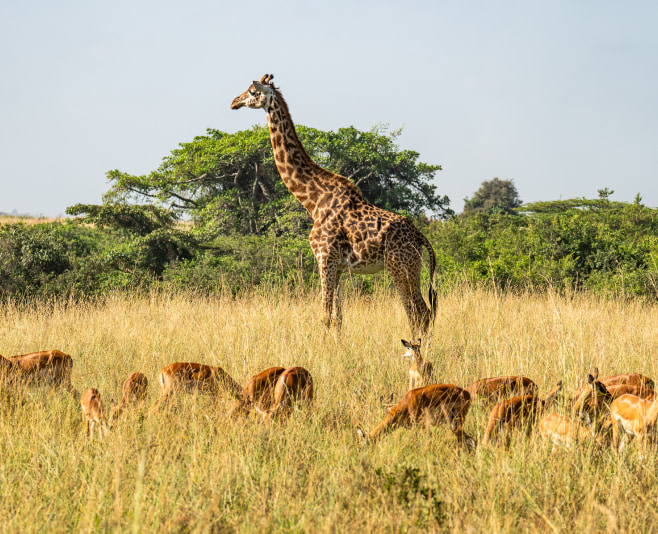
Wildlife viewing in Nyerere National Park is best from June to October, during the dry season
Nyerere national park fees and opening hours
Park Entrance Fees
|
Visitor Type |
Adult |
Child (5–15 years) |
Children Under 5 |
| Non-Resident (Foreign) | $50 – $70 | $20 – $30 | Free |
| Resident Foreigner | $50 – $60 | $20 – $30 | Free |
| East African Citizen | TSh 10,000 | TSh 2,000 – 3,000 | Free |
Camping Fees
|
Camping Type |
Non-Resident (Foreign) |
Resident Foreigner |
East African Citizen |
| Public Campsite (Adult) | $30 | $30 | TSh 5,000 |
| Public Campsite (Child) | $20 | $20 | TSh 3,000 |
| Private Campsite (Adult) | $50 | $50 | TSh 10,000 |
| Private Campsite (Child) | $30 | $30 | TSh 5,000 |
Vehicle Entry Fees
|
Vehicle Type (Foreign Plates) |
Fee Range |
| Light vehicles | $50 – $100 |
| Medium vehicles | $100 – $300 |
| Heavy vehicles & trucks | $300 – $500 |
Varies depending on tare weight and category.
Gates of Nyerere National Park
Because of its extremely large size and remote wilderness, Nyerere National Park has a number of entry gates, which are of essence to any visitor who is travelling in any direction. The gates are useful in controlling the number of people visiting these parks, security, and facilitate smooth park operations.
Matambwe Gate
This is the primary and most popular gate, situated on the northern side of the park. It is the first point of entry of a tourist who is planning to travel via Dar es Salaam, Morogoro, or Mikumi. Matambwe Gate, located on the northern side of the park, is the primary and most popular entry point. It is well-equipped with ticketing, information, and briefing facilities. Most of the safari lodges and camps in the northern sector utilize this gate as their operation base.
Mtemere Gate
Mtemere Gate is located at the eastern bank, and the gate is frequently used by those visitors who come to conduct boat safaris and visitors who reside in lodges that are located at the banks of the Rufiji River. For many travelers coming via Kibiti Town, Mtemere Gate is the main and most preferred entry and exit point due to its location on the primary road from Kibiti. However, Matambwe Gate remains the principal gate for those approaching from Morogoro or the former Selous Game Reserve areas. It is also a well-frequented introduction to fly-in safaris because there are a few airstrips around this region.
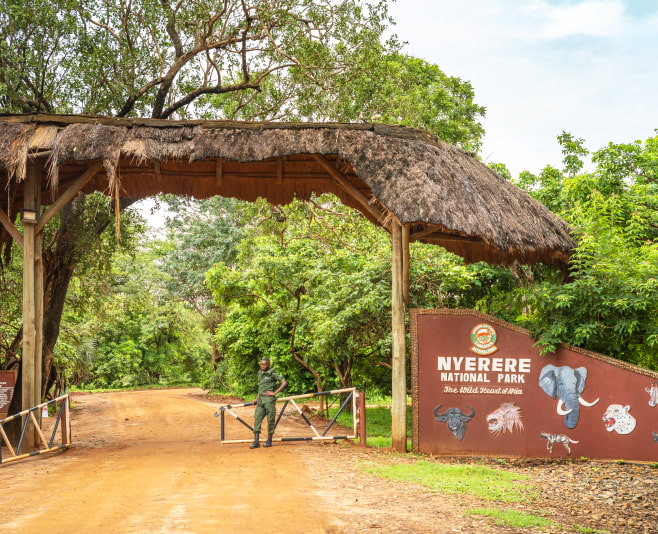
This gate is the main gate and most preferred entry and exit gate to Nyerere national park because it is on the main road from Kibiti Town
Mloka Gate
Located south of Mtemere, Mloka Gate is the side gate, which is not a frequently used access point as it serves people who visit the park's southern parts. It is convenient to particular camps and concessions that have been doing business in this more remote locale.
Kingupira Gate
Kingupira Gate is located on the west side and opens the path toward the wilder parts of the park. The more inaccessible position lessens its use, but it is of great significance to research teams, niche safaris, and adventurers who want to have an off-the-beaten-path experience.
Opening Hours: All gates are open every day between 6:30 am and 6:30 pm. People coming to visit the park are encouraged to come early, more so when wanting to go on a game drive or boat excursion so that they have a lot of wildlife viewing opportunities. Low-security entry into the night is restricted.
How to get to Nyerere national park
The journey to Nyerere National Park, the most remote and beautiful wilderness in Tanzania, is an adventure in itself. With the new infrastructural development and the boost in the number of safari tourists, you can reach the park through many means depending on your budget, time, and sense of adventure.
By Air
The quickest and most convenient method available to visit Nyerere National Park is by flight; this is especially the case if you are pressed for time or you are not interested in a long road trip. Some of the scheduled and charter flights are available on a daily basis in major cities:
- Nyerere National Park to Dar es Salaam: It is an average of 45-60 minutes. Flights are offered by several companies,such as Coastal Aviation and Auric Air, that land in airstrips such as Mtemere, Siwandu, Beho Beho, and so on.
- Zanzibar to Nyerere National Park: There are direct routes, and the flight lasts about 1 hour, so it is not difficult to plan a combined beach holiday with a safari.
- Arusha or Northern Circuit parks: Less frequent; there are charter flights between the northern parks of Tanzania and Nyerere depending on the route of those intending on an extensive Tanzanian safari.
Flying provides beautiful aerial scenery above the Rufiji River and the wide landscapes in the park. However, flights can be expensive, and smaller aircraft often have strict luggage weight limits
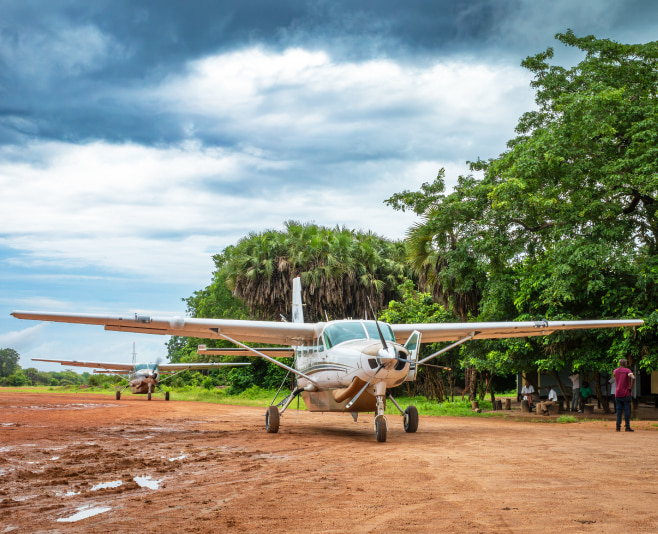
Flying is the quickest and most convenient option, especially for longer distances
By Road
Driving to Nyerere National Park is possible, particularly for adventurous travelers or those on a budget. From Dar es Salaam:
- The distance is about 200–250 km (depending on the gate) and takes roughly 5–7 hours.
- The journey to the park is on paved roads until you approach the park, where gravel roads take over. These roads can become dusty or muddy, especially during the rainy season
- Common routes pass through Kibiti and Mloka or via Morogoro toward the Matambwe Gate.
It is highly advisable to carry a 4x4 vehicle, as the terrain is rough mostly during the rainy season. The trip provides visitors with a view of countryside life and scenery in Tanzania and may become tiresome to certain visitors.
By Combined Transport
Other safari companies provide road and air packages, which means that the tourists drive to their destination and fly back. For example:
- The entire safari experience is to drive and fly back to save time to Dar es Salaam or Zanzibar.
- The flexibility of this option is an added value, along with the possibility of having a glance at local communities, not to mention the decrease of travel fatigue.
Transfers & Tours
A majority of visitors are enrolled in a packaged safari that leads to the park. All the logistic processes, such as airport transfers, park entrance charges, or game drives, are usually organized by the tour operators. This cannot be the most stressful journey to gain access to the Nyerere National Park, as the experience is always hitch-free and safe.
Tip:
Ensure that you always consult your safari company on travel times, road conditions, and gate locations in the park. Whereas, air travel is a more secure option since some roads become impassable in the wettest months (March-April).
What to do in Nyerere National Park?
Nyerere National Park offers a variety of activities for both nature lovers and safari enthusiasts, from thrilling game drives to peaceful boat safaris along the Rufiji River. And how are you supposed to spend your time in Nyerere National Park when you are planning your very adventure there and are asking yourself what to do in Nyerere National Park? Here are the top activities you must not skip:
1. Game Drives
Here the ultimate safari experience is game drives. There are huge landscapes and few visitors, so your chances of seeing elephants, lions, buffaloes, giraffes, zebras, and even rare wild dogs are excellent because the place feels raw and untouched. Wildlife and golden photography are best in the early morning and late afternoon.
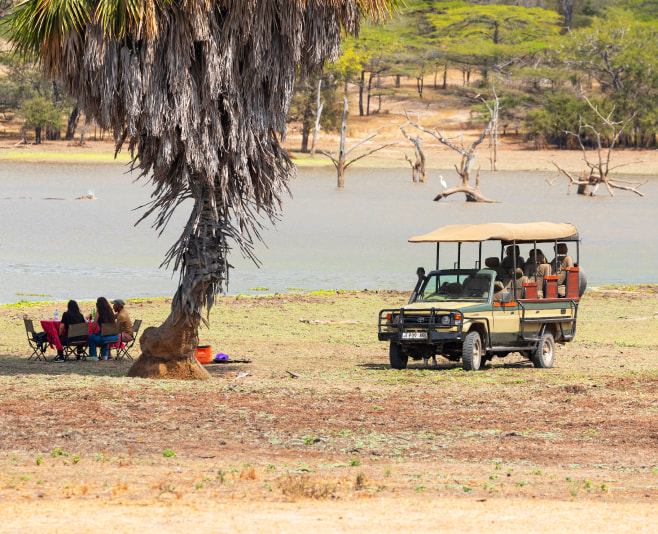
Embark on thrilling interactive safari game drives at Nyerere National Park
2. Rufiji River Boat Safaris
A boat trip along the Rufiji River is one of the most things to do in Nyerere National Park. Slide alongside pods of hippos, crocodiles lying in the sunbanks along the river, and colorful birds as you relax in the calmness of the waters. Sunset cruises are particularly magical, offering breathtaking reflections on the river. However, note that true nocturnal boat rides are not permitted, as the park closes at 6:30 PM unless special permission has been arranged.
3. Walking Safaris
A walking safari is one of the few things that places you face-to-face with the African wildlife. Guided by armed rangers and top-notch guides, these walks uncover the minute marvels of the bush tracks, medicinal plants, insects, and bird calls that you may not see in a vehicle. It is a thrilling process to interact with nature.
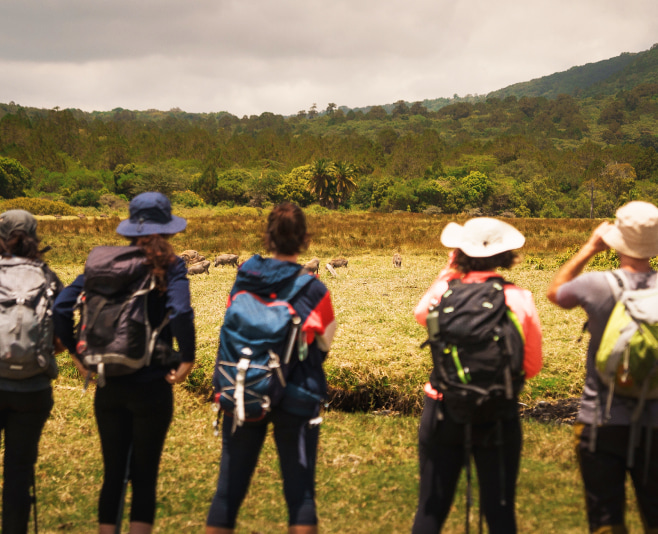
This short boat safari along the Rufiji River is ideal for spotting Hippos, Crocodiles and plenty of different bird species
4. Birdwatching
People who love birds will be thrilled by more than 440 species that have been logged within the park. Also keep a watch out for colorful bee-eaters, kingfishers, African fish eagles, and the elusive Pel's fishing owl. The green season brings in the migratory birds, making the riverine habitats, lakes, and woodlands a birdwatcher's paradise.
5. Fishing Trips
The Rufiji River provides rich fishing to the adventurer who would want to have an alternative add-on to the safari. There is the catch-and-release excursion, which includes such species as tiger fish and catfish. Fishing groups go on excursions arranged most often by many lodges.
6. Cultural Visits
Ensure that the park interacts with people living near the park, e.g., the Matambwe and the Mloka village. Visits to the culture may involve some local dances, village tours, and the experiences of the way of life and culture among people who have lived hand in hand with this wild environment since time immemorial.
7. Scenic Photography
Be it the river at sunset, dramatic cloud formations during the rainy season, or animals in shapes against burning skies, Nyerere National Park has an unending potential to provide stunning photos. Don’t forget about your camera and additional memory cards!
Top accommodations in Nyerere National Park
Accommodation in the Nyerere National Park (previously Selous Game Reserve) is among the best of its kind in the region and most of the accommodations are luxury tented camps and lodges that offer a unique and close African safari experience. Here are some of the top-rated options, often highlighted for their prime locations, service, and wildlife viewing opportunities:
Luxury/High-End Camps & Lodges:
- Beho Beho: Many describe Beho Beho as one of the best safari lodges in Africa with good service, an amazing location on the hills overlooking the river, and their luxury stone cottages. It presents unbelievable scenery and highly personal experiences.
- Siwandu Camp: On the palm-fringed beach of Lake Nzerakera, Siwandu has been acclaimed as having lovely tented units, great guiding, and much wildlife around the camp, including hippos and elephants. It is divided into two camps so as to have an intimate feel.
- Roho Ya Selous: It is also under the popular Asilia Africa and is situated in the center of a peninsula looking over Lake Nzerakera, which is renowned as an excellent place to view wildlife. It provides luxurious rooms and tents.
- Sand Rivers Selous: An old and time-worn lodge, Sand Rivers is on a lovely bend of the Rufiji River. It is renowned for its excellent guiding, elegant design, and expansive types of activities, such as walking safaris and fly camping.
- Kiba Point Safari Lodge: Kiba Point is a more intimate sister camp to neighboring Sand Rivers and comprises luxuriously appointed thatch cottages with their own plunge pools and a personal staff.
- Azura Nyerere (previously Amara Nyerere): This luxury camp, which is located on the western section of the park, features high standards, air-conditioned rooms, and an emphasis on photography safaris.
- Serena Mivumo River Lodge: This luxury lodge sits among the banks of the Rufiji River and has modern comforts, but it could be said that it is not as wild as other tented camps.
Mid-Range to Upper Mid-Range Options:
- Rufiji River Camp: The camp has been in existence since 2000 and is currently one of the most established camps in Nyerere, providing comfortable tented accommodation with fabulous views of the Rufiji River. It is usually acclaimed due to its worth and traditional safari setting.
- Lake Manze Tented Camp: A basic and quite beautiful camp that is right on the lakefront of Lake Manze itself, which has regular elephant sightings all around the camp, and which is highly affordable in relation to the experience of a wilderness that one wants to see.
- Selous Impala Camp: This is a fashionable and small tent camp on the bank of the Rufiji River, which presents a standard balance of comfort and the close-to-nature experience.
- Selous Kinga Lodge: This lodge is outside the park, yet it offers good enough access to the park; it offers comfortable chalets and tents that overlook the surrounding plains.
Make decisions based on the amount you are willing to spend, the kind of luxury you want, and whether you want a riverfront where you can do a boat safari or a bush location to do a walking safari. Advance booking, particularly during the dry season, is highly desirable.
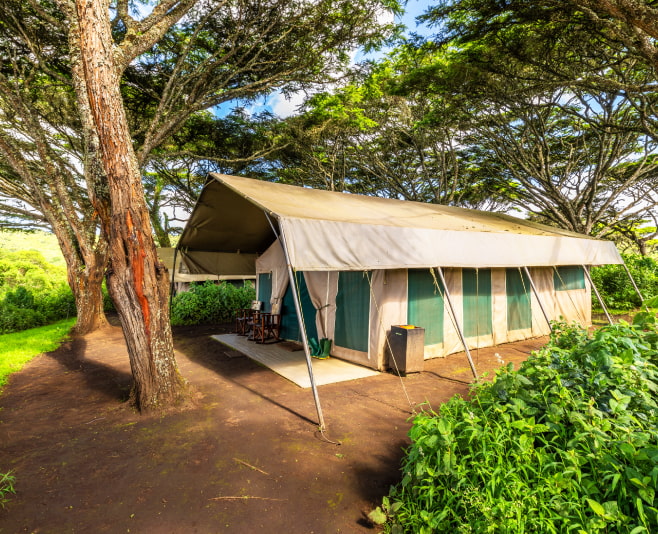
Accommodations in Nyerere national park include tented lodges, camps and hotels and they are categorized as budget, midrange and luxury facilities.
Practical Tips for Visiting Nyerere National Park
- Use of Fly-In Safari Is Advisable: Using a fly-in safari allows you to save on time and on the tiredness of travelling, since you land directly in Nyerere National Park. Dar es Salaam flights are also fast and convenient, thereby sparing you dusty long road trips.
- Engage in Other Activities: Do not stick to the game drives only. Nyerere is good at providing various activities. Take advantage of the special boat trips in the Rufiji River close to the hippos and crocodiles, and certainly don a walking safari (available at lodges) to have a close look at the bush on a ground level as well.
- Malaria prophylaxis should be given the first priority. This is a malaria-prone area. Speak to your doctor several weeks before your travel to plan an anti-malarial drug. Another thing you should do is apply good insect repellent, not sparingly though, particularly at dawn and dusk.
- Drink Plenty of Fluid: The weather may be scorching in the park, particularly in the dry season. Drink lots of bottled or purified water during the day to maintain the level of hydration.
Pack Smart for the Wilderness:
- Clothing: Wear lightweight, breathable material clothes of neutral colors (khaki, green, brown, or grey). The long sleeves and the trousers are excellent ways of protection against sun and bugs too. Make sure that you bring something warm (such as a fleece or jacket) in case there are cool early mornings and evenings.
- Sun Protection: A wide-brimmed hat, sunglasses, and sunscreen with high SPF are a must.
Come with the bare necessities of photography equipment: You will want to get those amazing wildlife shots. Owning or renting a good camera with a powerful zoom lens (300 mm+ scales, especially recommended for wildlife), an extra set of batteries, and extra memory cards is very essential.
Learn to Embrace the Unpredictable Nature: Wildlife sightings are not guaranteed, and it matters not what time of year or what guide. Stay calm and have fun, enjoy the greatness of the view, and enjoy all the time spent in this really primitive world.
Take Care of the Environment: Nyerere is a wild, untouched area. To conserve this amazing ecosystem, you can always follow the park rules, dispose of waste accordingly, and leave a minimal carbon footprint in the park.
Essential Travel Documents
Make sure you have these key documents ready before and during your trip:
- Valid Passport: The passport has to be valid at least six months after the planned date that you will be leaving Tanzania, and it has to contain at least two unused pages where the stamp can be placed.
- Tanzania Visa: A visa in Tanzania is needed by most foreigners. As a rule, you can get an e-Visa in advance on the Internet before your arrival (it is better to do it), or you can get a visa on arrival at most major entry points. Enquire early enough about the particular requirements to your country of nationality.
- Proof of Onward/ Return Ticket: Immigration officers are likely to require evidence of your onward/return ticket.
- International Certificate of Vaccination (Yellow Fever Vaccination Certificate (if required)) In general, travelers to Tanzania must present proof of yellow fever vaccination only if arriving from a country where yellow fever is endemic (Yellow Fever Vaccination Certificate), with the exception of arriving or transiting passengers coming to or passing through a country where Yellow Fever is not at risk. Visit the latest Tanzanian Ministry of Health requirements or the travel advisories in your country.
- Travel Insurance Details: You can obtain your travel insurance policy details with easy reach, emergency contact telephone numbers and policy numbers. This is the most important that is related to unexpected situations such as health-related disasters or trip cancellations.
- Distribution of Important Documents: Keep the digital copy of the items (in your phone or in the cloud) and at least two physical copies of your passport, visa, and flight tickets in a separate place than the original ones.
- Lodge/Safari Itinerary: Ensure you either print or have electronically, in advance, your safari itinerary, using names of lodges and flight reference numbers to use to make transfer arrangements.
Conclusion
Nyerere National Park perfectly embodies Africa’s wild beauty, offering thrilling adventure and serene natural splendor; this park embraces the visitor with thrilling adventures and serene natural splendor. The park offers such a lush view full of wildlife in the vast plains and in the still waves of the Rufiji River; one corner will show something extraordinary.
Are you fascinated by the proximity to elephants, mesmerized by the bright birds, or desiring the calmness of a sunset boat safari? Nyerere has vowed to bring moments along with you well after your adventure. It is amongst the most diverse and least-visited parks in Tanzania, providing a first hand safari off the tourist tracks. Having a plan and an adventurous spirit of discovery, your adventure to Nyerere National Park will not be a mere trip but a deep connection with the fiercest yet awe-inspiring African wilderness.
Related Articles
- Top 15 Churches To Visit in Tanzania That Blend Beauty and History
- The Great Migration Tanzania Safari: A Complete Guide to the World’s Greatest Wildlife Show
- Ultimate Mtwara Tanzania Travel Guide: Best Things to Do and How to Plan Your Trip
- Tanzania Family Holiday Guide: Creating Memories That Last a Lifetime
- Tanzania Tourist e-Visa for First-Time Travelers: A Complete Online Application Guide











